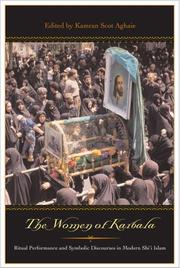| Listing 1 - 4 of 4 |
Sort by
|
Book
ISBN: 0804788855 9780804788854 9780804775670 0804775672 9780804775687 0804775680 Year: 2014 Publisher: Stanford, Calif. Stanford University Press
Abstract | Keywords | Export | Availability | Bookmark
 Loading...
Loading...Choose an application
- Reference Manager
- EndNote
- RefWorks (Direct export to RefWorks)
Outside of Shiraz in the Fars Province of southwestern Iran lies "Aliabad." Mary Hegland arrived in this then-small agricultural village of several thousand people in the summer of 1978, unaware of the momentous changes that would sweep this town and this country in the months ahead. She became the only American researcher to witness the Islamic Revolution firsthand over her eighteen-month stay. Days of Revolution offers an insider's view of how regular people were drawn into, experienced, and influenced the 1979 Revolution and its aftermath. Conventional wisdom assumes Shi'a religious ideology fueled the revolutionary movement. But Hegland counters that the Revolution spread through much more pragmatic concerns: growing inequality, lack of development and employment opportunities, government corruption. Local expectations of leaders and the political process—expectations developed from their experience with traditional kinship-based factions—guided local villagers' attitudes and decision-making, and they often adopted the religious justifications for Revolution only after joining the uprising. Sharing stories of conflict and revolution alongside in-depth interviews, the book sheds new light on this critical historical moment. Returning to Aliabad decades later, Days of Revolution closes with a view of the village and revolution thirty years on. Over the course of several visits between 2003 and 2008, Mary Hegland investigates the lasting effects of the Revolution on the local political factions and in individual lives. As Iran remains front-page news, this intimate look at the country's recent history and its people has never been more timely or critical for understanding the critical interplay of local and global politics in Iran.
Villages --- Political culture --- Culture --- Political science --- Hamlets (Villages) --- Village government --- Cities and towns --- Iran --- History --- Politics and government --- Internal politics --- anno 1970-1979 --- anno 1980-1989
Book

ISBN: 1978818483 Year: 2021 Publisher: New Brunswick : Rutgers University Press,
Abstract | Keywords | Export | Availability | Bookmark
 Loading...
Loading...Choose an application
- Reference Manager
- EndNote
- RefWorks (Direct export to RefWorks)
Muslim marriages have been the focus of considerable public debate in Europe and beyond, in Muslim-majority countries as well as in settings where Muslims are a minority. Most academic work has focused on how the majority Sunni Muslims conclude marriages. This volume, in contrast, focuses on Twelver Shia Muslims in Iran, Pakistan, Oman, Indonesia, Norway, and the Netherlands. The volume makes an original contribution to understanding the global dynamics of Shia marriage practices in a wide range of contexts--not only its geographical spread but also by providing a critical analysis of the socio-economic, religious, ethnic, and political discourses of each context. The book sheds light on new marriage forms presented through a bottom up approach focusing on the lived experiences of Shia Muslims negotiating a diverse range of relationships and forms of belonging.


ISBN: 9780292796577 9780292709362 0292796579 9780292709591 Year: 2021 Publisher: Austin
Abstract | Keywords | Export | Availability | Bookmark
 Loading...
Loading...Choose an application
- Reference Manager
- EndNote
- RefWorks (Direct export to RefWorks)
Commemorating the Battle of Karbala, in which the Prophet Mohammad's grandson Hosayn and seventy-two of his family members and supporters were martyred in 680 CE, is the central religious observance of Shi'i Islam. Though much has been written about the rituals that re-enact and venerate Karbala, until now no one has studied women's participation in these observances. This collection of original essays by a multidisciplinary team of scholars analyzes the diverse roles that women have played in the Karbala rituals, as well as the varied ways in which gender-coded symbols have been used within religious and political discourses. The contributors to this volume consider women as participants in and observers of the Karbala rituals in Iran, Iraq, Lebanon, India, Pakistan, and the United States. They find that women's experiences in the Shi'i rituals vary considerably from one community to another, based on regional customs, personal preferences, religious interpretations, popular culture, and socioeconomic background. The authors also examine the gender symbolism within the rituals, showing how it reinforces distinctions between the genders while it also highlights the centrality of women to the symbolic repertory of Shi'ism. Overall, the authors conclude that while Shi'i rituals and symbols have in some ways been used to restrict women's social roles, in other ways they have served to provide women with a sense of independence and empowerment.
Karbalāʼ, Battle of, Karbalāʼ, Iraq, 680 --- Muslim women --- Religious life --- Shīʻah --- Karbalāʾ (Iraq), Battle of, 680 --- Kerbela, Battle of, Karbalāʾ, Iraq, 680 --- Imamites --- Shia --- Shiism --- Twelvers (Islam) --- Islamic sects --- Alids --- Religious life (Islam) --- Rituals
Book

ISBN: 9781845457952 1845457951 9781845456269 1845456262 1282627104 9781282627109 9786612627101 6612627107 0857456520 9780857456526 Year: 2010 Publisher: New York Oxford
Abstract | Keywords | Export | Availability | Bookmark
 Loading...
Loading...Choose an application
- Reference Manager
- EndNote
- RefWorks (Direct export to RefWorks)
| Listing 1 - 4 of 4 |
Sort by
|

 Search
Search Feedback
Feedback About UniCat
About UniCat  Help
Help News
News